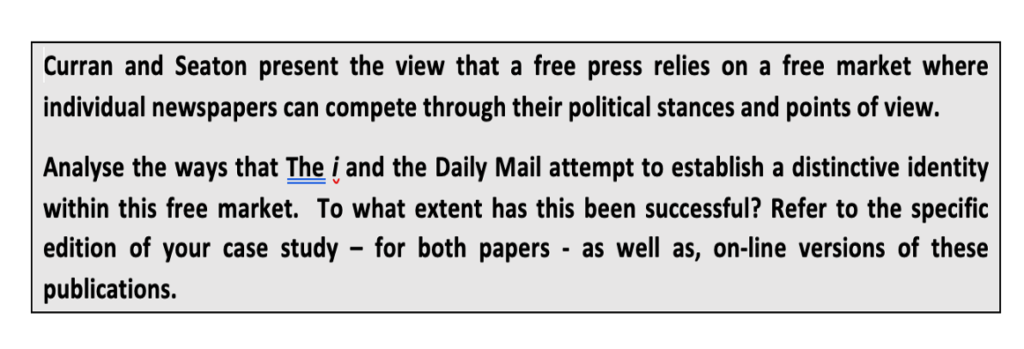Curran and Seaton present the view that a free press relies on a free market where individual newspapers can compete through their political stances and points of view.
Analyse the ways that The i and the Daily Mail attempt to establish a distinctive identity within this free market. To what extent has this been successful? Refer to the specific edition of your case study – for both papers – as well as, on-line versions of these publications.
Curran and Seaton’s summary of the theory of Liberal Free Press posits that “the freedom to publish in the free market ensures that the press reflects a wide range of opinions in society” In essence, the Liberal argument rests on the case that the free market is representative of the public’s needs and desires, and that the press therefore acts as “the people’s watchdog, scrutinising the actions of the government and holding the country’s rulers to account”. As the theory claims, Newspapers in a free market are aligned with the public interest because they must keep the loyalty of their readers to stay successful, and those newspapers that do not “respond to the concerns of their readers”, as Curran and Seaton phrase it, cannot be successful in a competitive space where alternative news outlets do respond to the concerns of their readers. In the theory of Liberal Free Press, the free market is touted as the institution that protects the freedom of the public and prevents the press from being untruthful or unrepresentative of the public interest, by holding the press accountable to the public.
The Daily Mail is a traditionally right-wing newspaper owned by Jonathan Harmsworth, 4th Viscount Rothermere, a descendent of the newspapers’ original founders, Harold and Alfred Harmsworth who introduced the newspaper in 1896. The I, on the other hand, was founded in 2010 as a sister paper the Independent, a newspaper in which the views expressed tend to align with liberalism. However, the I was bought by the Daily Mail and General Trust (DMGT) on 29 November 2019, for £49.6 million. DMGT is the conglomerate that owns the Daily Mail, and through purchasing the I the Daily Mail and General Trust has performed horizontal integration to extend their reach and income. Both newspapers are a part of capitalist media, meaning that the primary objective of the corporation that owns them is to make money, and not necessarily to produce newspapers that are balanced or informative sources of information. The Daily Mail circulates 1,158,192 copies, currently the most successful UK newspaper in terms of circulation. The daily mail’s main target audience is the lower middle class (C1). The Daily Mail is a middle-market newspaper, meaning that it is aimed towards readers who prefer entertainment as well as informational articles. The daily mail also has a majority female readership, with female readers consisting of 52-55% of the total daily mail readership. The I, as stated by the editor Oliver Duff, is a compact newspaper designed for people who do not have much time to read a newspaper, usually due to most of their time being taken up at work. As of October 2019, the Daily circulation of the I was 221,083. The main target audience is mostly middle-class people since the newspaper focuses on combining brevity with depth, allowing commuters to read it while they have time to get to work. Both newspapers have established their distinctive identities in the free market by appealing towards different interests of the public, and the Daily Mail, with the largest circulation of any UK newspapers has been very successful in creating profit. It can also be argued that since the daily mail sells so many copies and has such a large readership that it has been successful in representing the views of the public and has proven the liberal theory of the free press by being representative of the public interest. The I, while less successful financially, has also been successful in gaining a dedicated audience, showing how the newspaper has been representative of the interest of their target audience.
Curran and Seaton write that, in an election: “The press’s autonomy enables it to fearlessly scrutinize government, brief the electorate, stage a national debate and relay public opinion to authority.” However, an article published by The Daily Mail on 4th November 2020 pertaining to the US election indicates a problem with the idea of Liberal Free Press. Entitled “What Joe needs to stagger home”, the article includes subtle references to how the predicted president elect at the time, Joe Biden of the Democratic Party, is unfit for the position due to his age, indicated by the use of the phrase “stagger home”. The problem is that the article’s writer may have been influenced to imply this because of the pattern of ownership in the Daily Mail. Jonathan Harmsworth, the owner of DMGT and the Daily Mail newspaper, is a descendent of the newspapers’ original owners and is extremely rich, with his net worth being around 1.19 billion US dollars as of August 2017. Left-wing ideas are likely unfavourable for Harmsworth because of his wealth, and as a result he is likely to oppose the left-wing ideas of the distribution of wealth and welfare. Because he owns a newspaper and is powerful, this seems to go against the Liberal idea that newspapers are autonomous from the government and powerful individuals and instead suggests that the ideas expressed in newspapers owned by powerful capitalists are influenced by the views of those who own the newspapers, and therefore use them to spread their ideas. The I, on the other hand, appears to be very successful in establishing itself as the ideal liberal free newspaper that is balanced and informative. In the I’s 4th November issue, the front page and the articles inside are far more neutral, as opposed to the Daily Mail’s subtle right-wing bias. Articles entitled: “No winners in this battle” and “Tense wait on three states that decide the next president” suggest that, despite the fact that DMGT own the I, they have remained the neutral and informative newspaper they claim to be.
However, some theorists whose work relates to audience theory suggest that the free market may not be an entirely truthful or accurate model of the state of the press and newspapers which challenges the theory of liberal free press. Paul Lazarfeld introduced the idea that media communication is a two-step flow model in which thought leaders act as the filters of ideas shown in the media to the public masses and thus, they add another layer of interpretation, making their information subject to bias, interpretation, amplification, support and change. Therefore, based on the theory of Lazarfeld, the press is not selling copies to everyone who agrees with them because of their own convictions they have had the freedom to choose themselves, but rather the ideas of readers are influenced by the other readers around them, who can act as thought leaders and influence others with their interpretations. This can influence other people to certain political views and since the newspapers publish opinions on politics people can stick to reading certain newspapers not because of how the newspapers act in the public interest, but rather because they agree to the views most expressed by the newspapers. This links to the theory of surveillance capitalism by Shoshana Zuboff, in which harvested data of people is used online to target them with advertisements that influence their views and thus what media they consume, and what political views they align with. Noam Chomsky’s theory of five filters of mass media also links to these ideas as he introduces the idea that major news corporations act as gatekeepers of information that they “filter” to push the ideas they want to influence people with. This can be seen in the Daily Mail, as the ownership and organisation of the Daily Mail as a capitalist news organisation that also owns the I enforces the ideas of capitalism as it benefits them the most.
Overall, The Daily Mail and The I have both been successful in establishing their own identities in the free market despite the capitalist ownership and influences from the powerful owners of the newspapers. This is because both newspapers, although the Daily Mail is more right-wing and the I is more left-wing, display some articles that have differing viewpoints from the norm, indicating that the idea of Liberal Free Press is not groundless since it is backed up by the examples of the Daily Mail and the I.




